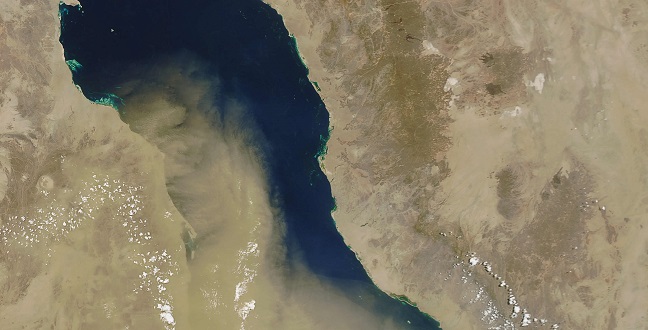Earth Science and Engineering
Modeling dust flow from Africa to Arabia
High-resolution modeling improves understanding of dust flow from Africa across the Red Sea toward the Arabian peninsula.


Airborne dust over the Red Sea as imaged by NASA’s Aqua satellite in June 2016.
© 2016 NASA image by Jeff Schmaltz, LANCE/EOSDIS Rapid Response
Violent dust storms that carry dust over the Red Sea from Africa and toward Saudi Arabia can look spectacular from space. The dust brings nutrients into the Red Sea ecosystem and affects the solar energy balance and air quality across the region, with implications for health, climate, agriculture and industry.
Researchers at KAUST have used a high-resolution computational model of summer dust storms that will help to decipher and predict the effects of these major atmospheric events1.
One major mechanism generating the dust storms is known as haboob, and is associated with wind gusts produced by moist downdrafts from convection.
“This convection is of small scale and usually is not resolved in the models,” explained KAUST Professor Georgiy Stenchikov, who heads a research group at the University that investigates the atmosphere and climate of the Red Sea and Arabian Peninsula. “Our model simulates the dynamics of haboobs from first principles.”
A key innovation of the new study is that it comprehensively encompasses all of the important processes. It examines in greater detail how dust is generated, transported through the atmosphere and then deposited in the sea or on land. The study also examines the radiative impact of the dust—the extent to which it alters the amount of energy from sunlight penetrating different layers of the atmosphere and down to the Earth’s surface.
The researchers applied the model to study a severe dust outbreak in June 2012, which allowed them to better understand and quantify these events more generally. Having real data to compare with the output generated through the model also offered a test of the reliability of the computer system.
“The results from our model compare well with ground-based and satellite observations,” said Stenchikov.
He pointed out, however, that the model generally underestimates some effects of the dust on the penetration of solar energy through the atmosphere. Identifying such deficiencies would help refine the model and increase its usefulness. Stenchikov said that gaining a better understanding of the properties of the soil that generates the dust is a priority for future improvement. He emphasized there is still more to learn about the origins of the dust.
This new work complements other studies by KAUST teams that are providing ever-better understanding of how dust and atmospheric conditions affect the sea and soil across the Arabian Peninsula and the impact of these on fisheries and agriculture.
References
- Kalenderski, S. & Stenchikov, G. High-resolution regional modeling of summertime transport and impact of African dust over the Red Sea and Arabian Peninsula. Journal of Geophysical Research: Atmospheres 121, 6435-6458 (2016).| article
You might also like

Earth Science and Engineering
Sensing color cues to monitor coral health in the Red Sea

Earth Science and Engineering
Kahramanmaraş earthquake study showcases potential slip rate errors

Chemical Engineering
Unveiling the role of biomass-burning aerosols in atmospheric reactions

Earth Science and Engineering
Feeling the heat across the Middle East

Applied Mathematics and Computational Sciences
Past and future drought patterns across the Arabian Peninsula

Earth Science and Engineering
Fewer major earthquakes for the northern Dead Sea Fault

Applied Mathematics and Computational Sciences
Measuring the impact of desert greening

Applied Mathematics and Computational Sciences



